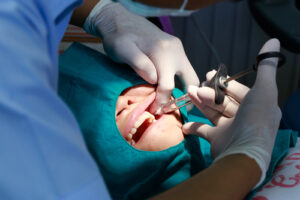Guide to Recovery from an Emergency Extraction Part 2
 Rapid recovery from an emergency tooth extraction requires appropriate aftercare.
Rapid recovery from an emergency tooth extraction requires appropriate aftercare.
Tooth extraction can cause some damage to the surrounding tissue including gum tissue and bone tissue, especially when complex tooth extractions are concerned.
For more details on aftercare following emergency dental extractions for patients from Escondido and other areas, read on!
How long does it take for gums to heal after extractions?
Gums heal faster than the skin and bone tissue. The original blood clot will have transitioned into fibrous tissue, although it may still be sensitive and prone to bleeding for some time.
It normally takes the first 24 hours for the bleeding to stop completely and for the blood clot to form. At this point, the gum tissue surrounding the wound will still be tender to touch, but the pain and discomfort will have started to subside. Some swelling or inflammation may be there, but this is perfectly normal: it is your body’s natural response to the trauma and the beginning of the healing process.
Your gums should begin to heal 3 days after removal, but they will still be tender and swollen. You should be careful not to disrupt the healing process.
Approximately 15-21 days after your procedure, the hole left by the extraction will have become nearly closed. As time goes by, the gums will begin to completely close off the hole left by the tooth extraction.
Even after the healing process has been nearly completed and you no longer experience pain, discomfort or irritation, the site may still be somewhat tender. It is the trauma to the jaw bone caused by extraction that will take longer to heal than the gum tissue itself.
What helps gums heal faster after tooth extraction?
In the initial period following the extraction, it is important to:
- Get plenty of rest
- Change the gauze as necessary but allow the clot to form
- Avoid rinsing, swishing, or gargling during the clotting process, as this may dislodge a newly formed clot, disrupt the healing process and affect the healing time.
- Avoid using straws as they put negative pressure on the blood clot
- Avoid spitting as this, too, builds negative pressure in the mouth
- Refrain from smoking
Additionally:
- Use over-the-counter pain relievers to reduce pain, swallowing and inflammation, as well as any other medications recommended by your dental surgeon.
- Use cold compresses to dull the pain
- Elevate the head to prevent blood from pooling
To promote healing and prevent infections and complications following a tooth extraction, you can use saline rinses, maintain dental and oral hygiene while avoiding the extraction site and follow a soft, non-chew diet.
How do you know if your gums are healing after a tooth extraction?
About a month after your tooth extraction, new gum tissue will have become formed at the extraction site. There may be a slight indent where the tooth used to be.
The jawbone will begin to heal approximately one week after the extraction and it will increasingly harden as time goes by. New bone tissue should fill in the hole within 10 weeks. It will usually take 4 months for the bone tissue to completely fill it in. It will roughly take 8 months for the edges of the new bone tissue to become even with the old bone.
Emergency dental extractions for patients in Escondido and nearby areas

Whether it’s a planned procedure or an emergency one, we take a consistent approach to patient care.
We are diligent about preparation, execution and follow-up, and we will ensure your safe and smooth recovery so you can start organizing that long-awaited family picnic at Dixon Lake.
Get in touch with us now!
Comments are closed.

